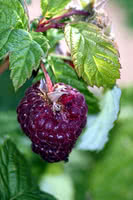Mon-Fri 9am - 5pm Mountain time
Black Elderberry vs Royalty Raspberry
Sambucus canadensis
Rubus x Royalty
NOT AVAILABLE THIS SEASON - MIGHT RETURN
Black Elderberry is a deciduous shrub native to eastern North America. You can plant this shrub in moist areas and it will help stabilize your soil. You can also use it on rural properties anywhere you'd use a lilac.
Black Elderberries are considered to be partially self-pollinating. So while they will still produce some berries without cross-pollination, planting with another variety will increase yields. Consider planting with Ranch Elderberry or Bob Gordon Elderberry.
Warning: the seeds, stems, leaves, roots, and uncooked berries of the Black Elderberry are poisonous to humans when eaten in quantity. You should cook the berries to make them safe for human consumption.
Royalty Raspberry is a productive and delicious red-purple raspberry. It is a cross between a red raspberry and a black raspberry. Ripening in late August, the berries are ideal for homemade jams, preserves, and fresh eating.
If you are going for more of a classic red raspberry taste, pick the berries early. But if they are left on the cane until they are purple the taste will be sweeter.
Royalty Raspberry is a floricane-fruiting variety, meaning it primarily produces fruit on second-year canes (previous season’s new growth). They are also referred to as summer-bearing. In late winter or early spring, cut back all spent floricanes, leaving only last season's canes.
Raspberries are self-fertile, meaning they do not require cross-pollination from another variety to produce fruit.
This very popular extra large berried variety was developed at Cornell University.
Black Elderberry Quick Facts
Royalty Raspberry Quick Facts
Toxicity: leaves, stems, and uncooked berries are poisonous to humans

